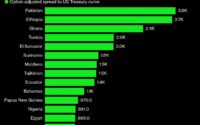Earlier this year, now former UK Prime Minister Boris Johnson said the country could become the Saudi Arabia of wind. In the United States, just last week, the House of Representatives passed the sweeping Inflation Reduction Act that will provide a huge financial push for more wind and solar. In Europe, Brussels is shortening approval procedures for renewables. And in China, they’re out of land for growing food.
Bloomberg reported earlier this month that a series of what it called extreme events, such as floods and droughts, had affected crops in the world’s wind and solar investment and capacity leader. This, in turn, had presented the authorities with a choice between continuing to use arable land for wind and solar, or using it for food.
Choosing between having food or having energy is not one that many people in the world would be comfortable with, especially people in the UK, the U.S. and Europe. The issue of renewables’ land footprint does not tend to get much, if any, attention from the media, which is why such a choice has not been considered at all. And yet some have researched it.
In 2013, a British researcher, David J.C. McKay, wrote a paper in which he calculated energy use per capita for several countries and compared it with the average energy density of solar panels and wind turbines, and—importantly—with population density.
It turned out that in the UK, people consumed an average of 1.25 Watts of electricity per square meter. Unfortunately, McKay also found that the average energy density of solar and wind farms was roughly the same. This meant that in a hypothetical and highly desirable scenario of Britain generating all its power from wind and solar, it would require a twofold increase in its own territory to have space to install the turbines and the panels.
“In a decarbonized world that is renewable-powered, the land area required to maintain today’s British energy consumption would have to be similar to the area of Britain,” McKay himself concluded.
The paper might have sounded fantastical were it not for the recent events unfolding in China. According to the Bloomberg report, some authorities are already taking action against more wind and solar developments, with at least one solar project getting partially dismantled for alleged illegal construction and others being scrutinized a lot more closely.
Indeed, solar is the bigger offender as far s land footprints go. Wind farms in wheat or sunflower fields are a usual sight in some parts of the world. For solar, the fields would have to be removed. And now, researchers are working on ways to solve the conundrum.
Agrivoltaic is one approach to dealing with solar’s land footprint. As the name suggests, it combines agriculture with photovoltaics by installing the panels on arable land in such a way as to keep it arable. The approach, however, is not universal because it basically relies on crops that do not need much sunlight, which is a minority.
Experiments are being done with the angle at which panels are installed in a bid to reduce the space they occupy while still absorbing sufficient irradiation to produce decent amounts of electricity while the sun shines.
Yale Environment 360 reported recently on the various approaches to reducing the footprint of solar energy, including agrivoltaics, mounting the panels directly on the ground in deserts to increase production, and mounting the panels almost vertically to save land.
The reason that the land problem comes into the spotlight now is the renewed push for even faster rollout of renewables amid the current energy crunch gripping Europe and spreading across the world as Europe suddenly becomes a huge LNG supplier, pushing prices to all-time highs.
Related: Colombia’s New Leftwing President Is Hiking Taxes On Its Oil Industry
According to the International Energy Agency’s Net Zero by 2050 roadmap that the agency published last year, we would need to build 630 GW of new solar capacity every year until 2050 to hit net-zero targets. This amount is four times greater than the record solar installations seen in 2020, the Yale Environment 360 article noted, and land is finite.
In all fairness, land is not the only finite component necessary for this massive buildout of solar power, but it is the most important one because, as the situation in China has reminded us, land is used to grow food. One could argue in favor of things like hydroponics and urban gardening, but it could not be a serious argument—it’s all about scale, and to have crop-growing at a scale ensuring adequate food supply for any given population, you need land.
For China, which is one of few countries with abundant land resources, as it were, part of the solution seems to be moving wind and solar projects to more remote areas. But this, as the Bloomberg report noted, would lead to more challenges, namely getting the electricity from those remote areas to the cities that need it. In other words, wind and solar power will very likely become costlier because of the investments in new transmission lines that would need to be made.
For less territorially fortunate countries, however, the problem may be insurmountable for the simple reason that you cannot generate more land. Offshore wind is obviously a solution for wind, and northern Europe is betting very big on offshore wind. But offshore solar, sadly, won’t work, not in the northern seas of the densely populated continent.
By Irina Slav for Oilprice.com
More Top Reads From Oilprice.com:


